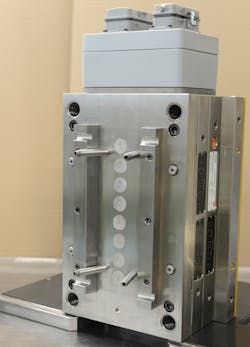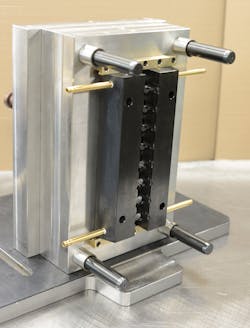Laser-sintered hot runners offer design flexibility
Hasco has expanded its hot-runner manufacturing capabilities, allowing it to quickly turn around custom hot runners with additively manufactured channels. It said the customizable units, called Streamrunners, are more compact and facilitate gentle passage of the melt, with less shear, resulting in better-quality parts.
The Streamrunners, officially launched at K2019 as an unnamed line of off-the-shelf products, now are available as tailored solutions, with both wired and prewired versions and single- and multi-cavity designs, from one drop to 96 drops. Unlike their forerunners, which were appropriate for only a narrow range of applications, the Streamrunners can take on many molding challenges.
“Of course, you can get a Streamrunner in the configuration like that shown on the K2019, but since then we moved on, and we now are not limited to specific plastics, shot weights or small pitches,” said Sebastian Hohenauer, a product manager at Hasco Austria GmbH in Guntramsdorf. “We deliver Streamrunners in all different sizes, shapes, pitches, and we can naturally balance systems, which could only be balanced in a rheological way before.”
The laser-sintered Streamrunners are made from a single manifold block in a single operation, reducing the possibility of leaks later, Hasco said.
The process enables freedom of design that allows mold makers to install nozzles in layouts that would otherwise not be possible, and to make especially large or curvaceous channels, Hohenauer said. With these advances, Hasco can create flow channels optimized to avoid sharp edges and areas with poor flow. These channels route the melt in more optimal ways and allow faster color changes.
Additive manufacturing also permits very close hole spacing and highly variable nozzle configurations.
“There are some arrangements of nozzles which can hardly be realized by using conventional methods to redirect the melt flow, if you want to naturally balance your system. The Streamrunner opens the door to these, sometimesIn addition to other design benefits, the Streamrunners are considerably smaller than some other hot runners on the market. Hasco offers them with a minimum distance of 18mm between the nozzles in a single row, and a minimum height of 26mm.
For elm-plastic GmbH, a Hasco customer in Dudeldorf, Germany, the Streamrunner’s compact size was a selling point. The molder needed a mold to make a small DIY-store part, but had limited installation height above its 56-ton press.
“The new Streamrunner has indeed made it possible to save 10mm on the mold thickness for this project, despite the complex installation situation and the demanding gating,” said Stephan Hatarik, a technical sales engineer at Hasco’s hot-runner division, headquartered in Europe. Because of the flexibility of the manufacturing process, the hot half also was more compact.
Hohenauer said Hasco can make melt channels of any size, in increments of tenths of a millimeter. In addition to the hot-runner manifolds, it can supply nozzles capable of producing shot sizes ranging from a few tenths of a gram to more than 2.2 pounds.
Prior to its launch of the Streamrunners, Hasco could additively manufacture tailored hot-runner manifolds, but lead times were longer, around 8 weeks, Hohenauer said.
“Before the Streamrunner, the usage of a printed hot runner was always something that had to be discussed and planned a long way ahead. Now, we have a product which can compete with the high standards of our manifold product range, as well as with the short quotation and design times as well as delivery dates, which our customers are accustomed to,” he said.
- Karen Hanna, associate editor
- [email protected]
Contact:
Hasco America Inc., Fletcher, N.C., 828-650-2600, www.hasco.com
About the Author
Karen Hanna
Senior Staff Reporter
Senior Staff Reporter Karen Hanna covers injection molding, molds and tooling, processors, workforce and other topics, and writes features including In Other Words and Problem Solved for Plastics Machinery & Manufacturing, Plastics Recycling and The Journal of Blow Molding. She has more than 15 years of experience in daily and magazine journalism.


